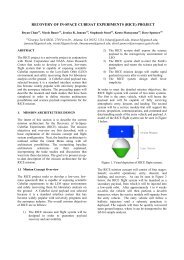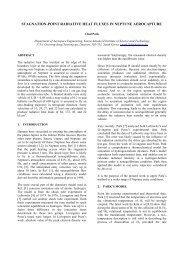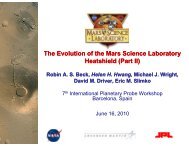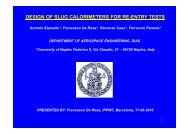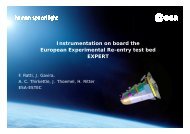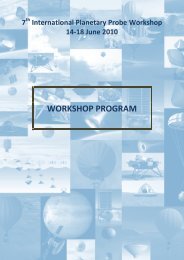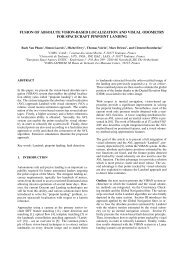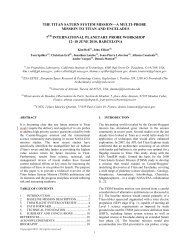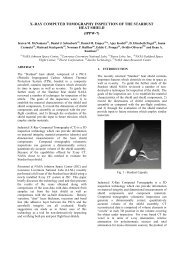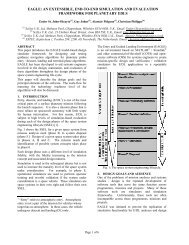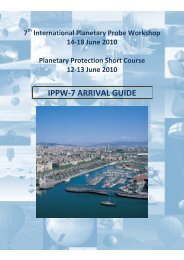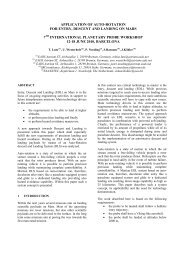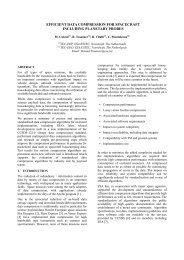mission analysis - International Planetary Probe Workshop
mission analysis - International Planetary Probe Workshop
mission analysis - International Planetary Probe Workshop
You also want an ePaper? Increase the reach of your titles
YUMPU automatically turns print PDFs into web optimized ePapers that Google loves.
T AND<br />
LA ANDI ING MISS<br />
SION<br />
AN NALYS SIS<br />
CENT<br />
EXO OMAR RS ENTR<br />
RY, DESC<br />
OF THE<br />
EVOLUTION OF THE EXOMARS<br />
ENTRY DESCENT AND LANDING<br />
MISSION ANALYSIS<br />
Session 3<br />
Rodrigo Haya Ramos, Juan Luis Cano, Davide Bonetti,<br />
Cristina Parigini, Francesco Cacciatore<br />
DEIMOS Space, Spain<br />
Stefano Portigliotti, Alberto Anselmi -<br />
Thales Alenia Space, Italy<br />
Olivier Bayle<br />
ESA/ESTEC, The Netherlands<br />
ION<br />
EVOLUTI<br />
© 2010 DEIMOS Space S.L.U. – www.deimos-space.com<br />
7th <strong>International</strong> <strong>Planetary</strong> <strong>Probe</strong> <strong>Workshop</strong><br />
- 1 - Barcelona, 14-1818 th June 2010
EXO OMAR RS ENTR<br />
RY, DESC<br />
CENT<br />
AND<br />
LA ANDI ING MISS<br />
SION<br />
AN NALYS SIS<br />
THE<br />
ION OF T<br />
EVOLUTI<br />
• Motivation and Objective<br />
• ExoMars Missioni<br />
• Evolution of Mission Scenario<br />
• Interplanetary Mission<br />
• Arrival Conditions<br />
• EDL Requirements<br />
• Global Entry Corridor<br />
• Mission Performances<br />
• Conclusions<br />
Agenda<br />
© 2010 DEIMOS Space S.L.U. – www.deimos-space.com<br />
7th <strong>International</strong> <strong>Planetary</strong> <strong>Probe</strong> <strong>Workshop</strong><br />
- 2 - Barcelona, 14-1818 th June 2010
EXO OMAR RS ENTR<br />
RY, DESC<br />
CENT<br />
AND<br />
LA ANDI ING MISS<br />
SION<br />
AN NALYS SIS<br />
OF THE<br />
EVO LUTI ION<br />
Motivation and Objective<br />
• Project Motivations<br />
– ExoMars is ESA’s current <strong>mission</strong> to planet Mars aimed for two<br />
launches: 2016 2018<br />
– ExoMars is the first Aurora Flagship <strong>mission</strong> under assessment<br />
– Project is currently undergoing Phase B2 studies under ESA<br />
management and Thales Alenia Space Italia project leadership<br />
– DEIMOS Space provides support to TAS-I on interplanetary and<br />
in-orbit Mission Analysis and Design<br />
– DEIMOS Space is responsible for the Mission Analysis and Design<br />
for the Entry, Descent and Landing (EDL) activities. i i Within this<br />
contract, Tessella is responsible for the support to sizing and<br />
<strong>analysis</strong> of the Descent and Landing System<br />
• Presentation Objectives<br />
– The Mission requirements have evolved since the beginning g of<br />
Phase B leading to significant changes in the Mission & System<br />
Design<br />
– An overview of the evolution of the Mission from an EDL Mission<br />
Design and Analysis standpoint is presented<br />
© 2010 DEIMOS Space S.L.U. – www.deimos-space.com<br />
7th <strong>International</strong> <strong>Planetary</strong> <strong>Probe</strong> <strong>Workshop</strong><br />
- 3 - Barcelona, 14-1818 th June 2010
OF THE EXO OMAR RS ENTR<br />
RY, DESC<br />
CENT<br />
AND<br />
LA ANDI ING MISS<br />
SION<br />
AN NALYS SIS<br />
EVO LUTI ION<br />
• Technological objectives<br />
– Entry, Descent and Landing (EDL) of a payload<br />
on the surface of Mars;<br />
– Surface mobility with a Rover,<br />
– Access to the sub-surface surface to acquire samples;<br />
– Sample preparation p and distribution for analyses<br />
by scientific instruments.<br />
• Scientific Objectives<br />
– To search for signs of past and present life on<br />
Mars;<br />
– To investigate the water/geochemical<br />
environment as a function of depth in the<br />
shallow subsurface;<br />
– To investigate Martian atmospheric trace gases<br />
and their sources.<br />
• The ExoMars Mission will deploy two elements:<br />
– EDL Demonstrator with a Surface Platform (SP)<br />
– a high-mobility Rover<br />
Exomars Mission<br />
© 2010 DEIMOS Space S.L.U. – www.deimos-space.com<br />
7th <strong>International</strong> <strong>Planetary</strong> <strong>Probe</strong> <strong>Workshop</strong><br />
- 4 - Barcelona, 14-1818 th June 2010
ING MISS<br />
SION<br />
AN NALYS SIS<br />
ION OF THE EXO OMAR RS ENTR<br />
RY, DESC<br />
CENT<br />
AND<br />
LA ANDI<br />
•<br />
Credits: LMCo<br />
Atlas V (421)<br />
Actual Mission Scenario<br />
EVOLUTI<br />
Credits: ESA<br />
© 2010 DEIMOS Space S.L.U. – www.deimos-space.com<br />
7th <strong>International</strong> <strong>Planetary</strong> <strong>Probe</strong> <strong>Workshop</strong><br />
- 5 - Barcelona, 14-1818 th June 2010
EXO OMAR RS ENTR<br />
RY, DESC<br />
CENT<br />
AND<br />
LA ANDI ING MISS<br />
SION<br />
AN NALYS SIS<br />
OF THE<br />
EVOLUTI ION<br />
Evolution<br />
• The <strong>mission</strong> Design has evolved during the Phase B as<br />
a result of<br />
– Updated Mission Requirements<br />
– Mission options trade-offs<br />
– Budget restrictions<br />
ti<br />
– Cooperation with NASA<br />
• The Mission Design during Phase B has developed<br />
several Mission Baselines<br />
Phase Frame Final Review<br />
B1 October 2005 – March 2007 SRR<br />
B1X April 2007 – December 2007 BCR<br />
B2 January 2008 – March 2009 I‐PDR<br />
B2X April 2009 ‐ Mach 2010 B2XR<br />
B2X2 April 2010 ‐ Mach 2011 PDR<br />
© 2010 DEIMOS Space S.L.U. – www.deimos-space.com<br />
7th <strong>International</strong> <strong>Planetary</strong> <strong>Probe</strong> <strong>Workshop</strong><br />
- 6 - Barcelona, 14-1818 th June 2010
N AN NALYS SIS<br />
SION MISS ING M<br />
ANDI D LA<br />
T AND<br />
CENT DESC<br />
RY, D<br />
EXO OMAR RS ENTR<br />
THE OF T<br />
LUTI ION<br />
EVO<br />
• Launcher<br />
• Carrier (CM) / Data Relay Carrier (DRC)<br />
• Orbiter Module (OM)<br />
• Carrier Science Relay Module (CSRM)<br />
• Descent Module Composite (DMC)<br />
EDL Demonstrator t Module (EDM)<br />
Enhanced Descent Module (EDM)<br />
• Lander<br />
Exomars Elements along Phase B<br />
• Rover<br />
Credits: ESA, NASA, TASI<br />
Images are illustrative, not corresponding to actual designs<br />
© 2010 DEIMOS Space S.L.U. – www.deimos-space.com<br />
7th <strong>International</strong> <strong>Planetary</strong> <strong>Probe</strong> <strong>Workshop</strong><br />
- 7 - Barcelona, 14-1818 th June 2010
EXO OMAR RS ENTR<br />
RY, DESC<br />
CENT<br />
AND<br />
LA ANDI ING MISS<br />
SION<br />
AN NALYS SIS<br />
OF THE<br />
LUTI ION<br />
EVO<br />
Descent Module (DM) Elements along Phase B<br />
Single and 2 stage<br />
parachute system<br />
BackShell &<br />
(drogue and Main)<br />
Structuret<br />
Liquid/Solid<br />
retrorockets<br />
Surface Platform (SP)<br />
with crushable structure<br />
Vented / non-<br />
vented Airbag<br />
Rover Stowed in<br />
Lander<br />
Crushable Structure<br />
FrontShield<br />
Images are illustrative, not corresponding to actual designs<br />
Credits: TASI<br />
© 2010 DEIMOS Space S.L.U. – www.deimos-space.com<br />
7th <strong>International</strong> <strong>Planetary</strong> <strong>Probe</strong> <strong>Workshop</strong><br />
- 8 - Barcelona, 14-1818 th June 2010
EXO OMAR RS ENTR<br />
RY, DESC<br />
CENT<br />
AND<br />
LA ANDI ING MISS<br />
SION<br />
AN NALYS SIS<br />
OF THE<br />
EVO LUTI ION<br />
• Mission Scenario<br />
Mission Scenario & EDL: Nominal<br />
Phase B1 Phase B1X Phase B2 Phase B2X Phase B2X / B2X2<br />
Option Baseline Baseline Baseline Baseline<br />
Baseline<br />
Spacecraft<br />
CM + DM<br />
Rover (ESA)<br />
CM + DM CM + DM (CM possibly as OM + Enh.DM OM + EDM Carrier, EDL,<br />
Orbiter)<br />
Rover (NASA)<br />
Opportunity<br />
2011 / 2013 2013 / 2016 2013 / 2016 2016<br />
2016 2018<br />
Launcher Soyuz 2-1b Ai Ariane 5 Ai Ariane 5 Atlas V 551 Atlas V 421 Atlas V 531<br />
Escape type<br />
From HEO with 4<br />
Direct Direct Direct Direct Direct<br />
escape burns<br />
Transfer type<br />
T3 with DSM T2 with DSM T2 with DSM T2 with DSM T2 with DSM T2 with DSM<br />
Release type<br />
Elliptic from 4-sol<br />
Elliptic from 4-sol<br />
Elliptic from 4-sol<br />
Hyperbolic<br />
Hyperbolic Elliptic<br />
orbit<br />
orbit<br />
orbit<br />
• EDL Architecture<br />
DM 70º/47º aeroshell 70º/47º aeroshell 70º/47º aeroshell 70º/47º aeroshell 70º/47º aeroshell<br />
3.4 m Diameter 3.4 m Diameter 3.4 m Diameter 3.4 m Diameter 2.4 m Diameter<br />
1 Ton 1.2 Ton 1.2 Ton 1.2 Ton 600 kg<br />
Descent System Single / 2 Stage<br />
2StageSystem System 2StageSystem System<br />
2 Stage System<br />
Single Stage<br />
System (DGB,<br />
(DGB, ringslot) (DGB, ringslot) (DGB, ringslot) System (DGB)<br />
ringslot)<br />
MSL derived<br />
Powered Descent Throttleable /<br />
Throttleable Throttleable Throttleable Modulated<br />
Solid<br />
Retrorockets Retrorockets Retrorockets Retrorockets<br />
Retrorockets<br />
Landing<br />
Vented / non-<br />
Crushable<br />
Vented airbag Vented airbag Vented airbag<br />
ventedairbag<br />
Structure<br />
© 2010 DEIMOS Space S.L.U. – www.deimos-space.com<br />
7th <strong>International</strong> <strong>Planetary</strong> <strong>Probe</strong> <strong>Workshop</strong><br />
- 9 - Barcelona, 14-1818 th June 2010
NALYS SIS<br />
N AN SION<br />
MISS ING M ANDI D LA T AND CENT DESC RY, D ENTR RS E OMAR<br />
THE EXO<br />
ION OF T<br />
LUTI<br />
EVO<br />
Credits: TASI<br />
EDL Sequence<br />
Enhanced DM<br />
EDL Demonstrator<br />
© 2010 DEIMOS Space S.L.U. – www.deimos-space.com<br />
7th <strong>International</strong> <strong>Planetary</strong> <strong>Probe</strong> <strong>Workshop</strong><br />
- 10 - Barcelona, 14-1818 th June 2010
EXO OMAR RS ENTR<br />
RY, DESC<br />
CENT<br />
AND<br />
LA ANDI ING MISS<br />
SION<br />
AN NALYS SIS<br />
OF THE<br />
EVO LUTI ION<br />
• Mission Scenario<br />
Mission Scenario & EDL: Trade-offs<br />
Phase B1<br />
Phase B1X Phase B2 Phase B2X<br />
Option Option 1 Option 2 Option 1 Option 1 Option 1<br />
Spacecraft<br />
CM + DM<br />
CM + DM<br />
As nominal +<br />
Orbiter + DM CM + DM (CM possibly as (CM possibly as<br />
Orbiter alone<br />
Orbiter)<br />
Orbiter)<br />
Opportunity 2011 / 2013<br />
2011 / 2013 / 2015<br />
(backup) (backup)<br />
2013 / 2016 2013 / 2016 2016<br />
Launcher Soyuz 2-1b Ai Ariane 5 Proton M Proton M Proton M<br />
Escape type<br />
Direct<br />
(Launch 3<br />
Direct Direct Direct Direct<br />
Transfer type<br />
th b f<br />
Direct with DSM<br />
T3 with DSM<br />
T3 & T4 with DSM<br />
T2 with DSM T2 with DSM T2 with DSM<br />
Release type<br />
N/A<br />
Elliptic & Elliptic from 4-sol Elliptic from 4-sol Elliptic from 4-sol<br />
SSO of 500 km hyperbolic orbit orbit orbit<br />
• EDL Architecture<br />
Phase B1<br />
Phase B2<br />
Phase B2X<br />
Phase B2X / B2X2<br />
Option Option 1 Option 1 Option 1 Option 1<br />
DM<br />
3.2 m Diameter<br />
3 m Diameter<br />
1.3 Tons<br />
1 Ton / 1.2 Tons 400 / 800 Kg<br />
Descent System<br />
Powered Descent<br />
Landing<br />
ringsail<br />
Solid retrorockets<br />
Non-Vented<br />
airbag<br />
Huygens DGB /<br />
Viking DGB<br />
© 2010 DEIMOS Space S.L.U. – www.deimos-space.com<br />
7th <strong>International</strong> <strong>Planetary</strong> <strong>Probe</strong> <strong>Workshop</strong><br />
- 11 - Barcelona, 14-1818 th June 2010
EXO OMAR RS ENTR<br />
RY, DESC<br />
CENT<br />
AND<br />
LA ANDI ING MISS<br />
SION<br />
AN NALYS SIS<br />
Interplanetary Mission Scenario<br />
• The interplanetary Transfer design has evolved as a result<br />
of the<br />
– The hyperbolic -Elliptic -Hyperbolic release evolution<br />
– Constrained arrival / release date – unconstrained arrival date<br />
– Direct / staged escape<br />
– Use of T1/T2 transfers - T3/T4 transfers<br />
– Arrival or not under MGDS<br />
PhB1: Soyuz, 2011 B2: A5, 2013<br />
Actual: A421, 2016<br />
Departure from Earth<br />
(December 2013)<br />
Departure from Earth<br />
(January 2016)<br />
OF THE<br />
EVO LUTI ION<br />
2.9 km/s<br />
DSM<br />
(May 2014)<br />
Arrival to Mars<br />
(October 2014)<br />
DSM<br />
(May 2016)<br />
Arrival to Mars<br />
(October 2016)<br />
© 2010 DEIMOS Space S.L.U. – www.deimos-space.com<br />
7th <strong>International</strong> <strong>Planetary</strong> <strong>Probe</strong> <strong>Workshop</strong><br />
- 12 - Barcelona, 14-1818 th June 2010
EVOLUTI ION OF THE EXO OMAR RS ENTR<br />
RY, DESC<br />
CENT<br />
AND<br />
LA ANDI ING MISS<br />
SION<br />
AN NALYS SIS<br />
Navigation<br />
• Navigation<br />
– Driven by Mars – Earth – GS Geometry (distance, angles)<br />
– Dedicated campaigns for each scenario<br />
– Delta DOR measurements as<br />
compulsory<br />
– Navigation assumptions have<br />
evolved towards reducing<br />
conservatism<br />
s<br />
– Drives EIP dispersion in case of<br />
hyperbolic release<br />
– Low impact for elliptic release<br />
© 2010 DEIMOS Space S.L.U. – www.deimos-space.com<br />
7th <strong>International</strong> <strong>Planetary</strong> <strong>Probe</strong> <strong>Workshop</strong><br />
- 13 - Barcelona, 14-1818 th June 2010
EVOLUTI ION OF THE EXO OMAR RS ENTR<br />
RY, DESC<br />
CENT<br />
AND<br />
LA ANDI ING MISS<br />
SION<br />
AN NALYS SIS<br />
Arrival Conditions<br />
• Arrival epoch<br />
– Driven by release strategy, visibility, surface operation constraints<br />
– Actually landing is foreseen in the middle of the EGDS<br />
• Arrival Conditions<br />
– Landing constrained to morning / early morning<br />
– Retrograde entry for Elliptic release for daylight landing<br />
© 2010 DEIMOS Space S.L.U. – www.deimos-space.com<br />
7th <strong>International</strong> <strong>Planetary</strong> <strong>Probe</strong> <strong>Workshop</strong><br />
- 14 - Barcelona, 14-1818 th June 2010
EXO OMAR RS ENTR<br />
RY, DESC<br />
CENT<br />
AND<br />
LA ANDI ING MISS<br />
SION<br />
AN NALYS SIS<br />
OF THE<br />
LUTI ION<br />
EVO<br />
EDL Mission Requirements<br />
• The main evolution of the EDL constraints For Mission<br />
Design concerns the change from the Enhanced<br />
Mission to the EDL demonstrator<br />
• System constraints t removed from M&SRD<br />
Phase B1<br />
Subject<br />
Requirement<br />
…<br />
Phase B2X2<br />
Landing Latitude 15ºS S, 45ºN Subject<br />
Requirement<br />
Nominal Surface Mission 180 sols outside MGDS<br />
Landing accuracy 25 km 3 (15 km goal)<br />
Landing time<br />
Daylight<br />
Landing altitude<br />
< 0 m MOLA<br />
Oscillations (parachute) < 10º<br />
Descent & Landing Loads < 40 g<br />
Entry Control concept ballistic<br />
Terrain Slopes<br />
EVOLUTI ION OF THE EXO OMAR RS ENTR<br />
RY, DESC<br />
CENT<br />
AND<br />
LA ANDI ING MISS<br />
SION<br />
AN NALYS SIS<br />
• lsPlot.fig<br />
EDL Entry Conditions<br />
Phase B1 B1X B2<br />
B2X B2X / B2X2<br />
Type Of Entry Hyperbolic<br />
Elliptic<br />
Elliptic<br />
Elliptic Hyperbolic<br />
Launch Opp. 2011 2013 2011 2013 2013 2016 2016 2016<br />
V [km/s] 2.89 2.78 N/A N/A N/A N/A N/A 3.25 : 3.46<br />
Inertial Velocity [m/s] 5719 5667 4851 4851 4851 4851 4851 5910 : 6030<br />
Heading [deg] 86 : 116 73 : 100 230 : 245 240 236 244 240 : 244 117 : 125<br />
Velocity [m/s] 5474 : 5563 5424 : 5511 5063 5063 5023 5089 5063 : 5068 5474 : 5563<br />
LT Min 10.8 : 13:1 10.9 : 13.2 8:3 : 9.5 9.5 9.2 9.9 10.9 : 11.3 13.4 : 13:7<br />
Design Site 15S : 45N<br />
15S : 45N<br />
4Sites<br />
Meridiani Meridiani<br />
*4 BCR Sites *MC<br />
EIP<br />
© 2010 DEIMOS Space S.L.U. – www.deimos-space.com<br />
7th <strong>International</strong> <strong>Planetary</strong> <strong>Probe</strong> <strong>Workshop</strong><br />
- 16 - Barcelona, 14-1818 th June 2010
EXO OMAR RS ENTR<br />
RY, DESC<br />
CENT<br />
AND<br />
LA ANDI ING MISS<br />
SION<br />
AN NALYS SIS<br />
OF THE<br />
EVO LUTI ION<br />
Entry Corridors<br />
• All the EDL Mission Constraints (thermomechanical,<br />
parachutes, RDA, landing accuracy… ) are collapsed in a<br />
single figure of merit: the Entry Corridor<br />
– Go / no-go for a particular landing site<br />
– Identification of Mission/DM i design issues<br />
– Support the DM sizing selection, landing windows, sizing cases<br />
– Foster the review of specifications and designs<br />
– Mission-trade offs<br />
• Actual Corridors for Meridiani pending of consolidation<br />
nation n (kW/m m2)<br />
Flux at stag<br />
Heat<br />
440<br />
420<br />
400<br />
380<br />
360<br />
340<br />
320<br />
300<br />
Elliptic, Meridiani v Ls<br />
Latitude (deg) = -2.0<br />
mass = 1079 kg<br />
mass = 1200 kg<br />
constraint<br />
280<br />
50 55 60 65 70 75 80 85<br />
Solar Longitude (deg)<br />
Hyperbolic, Meridiani vs V ∞<br />
© 2010 DEIMOS Space S.L.U. – www.deimos-space.com<br />
7th <strong>International</strong> <strong>Planetary</strong> <strong>Probe</strong> <strong>Workshop</strong><br />
- 17 - Barcelona, 14-1818 th June 2010
EVOLUTI ION OF THE EXO OMAR RS ENTR<br />
RY, DESC<br />
CENT<br />
AND<br />
LA ANDI ING MISS<br />
SION<br />
AN NALYS SIS<br />
Global Entry Corridors<br />
• Extension to a <strong>Planetary</strong> level of the Entry Corridors (LEC)<br />
• Powerful tool to:<br />
– identify landing Site candidates Extensively used and validated<br />
against Monte Carlo along Phase B (see Poster about it…)<br />
– Fast Evaluation of Mission i Performances in sites and epochs<br />
different from the design one (s)<br />
PhB2, Peak Heat Flux Map<br />
© 2010 DEIMOS Space S.L.U. – www.deimos-space.com<br />
7th <strong>International</strong> <strong>Planetary</strong> <strong>Probe</strong> <strong>Workshop</strong><br />
- 18 - Barcelona, 14-1818 th June 2010
D LA ANDI ING MISS<br />
SION<br />
AN NALYS SIS<br />
T AND CENT<br />
DESC RY, D ENTR RS E OMAR<br />
THE EXO<br />
ION OF T<br />
EVOLUTI<br />
Mission Performances 1/3<br />
• 3DOF/6DOF/Multibody Monte Carlo campaigns have been run<br />
for verification of predicted EC performances<br />
• End-2-End <strong>analysis</strong> with continuous interplanetary and EDL<br />
phases (ex: trajectory t and dispersion i analyses)<br />
Ph B2, Elliptic Release<br />
Ph B2X/B2X2 Hyperbolic<br />
© 2010 DEIMOS Space S.L.U. – www.deimos-space.com<br />
7th <strong>International</strong> <strong>Planetary</strong> <strong>Probe</strong> <strong>Workshop</strong><br />
- 19 - Barcelona, 14-1818 th June 2010
EVOLUTI ION OF THE EXO OMAR RS ENTR<br />
RY, DESC<br />
CENT<br />
AND<br />
LA ANDI ING MISS<br />
SION<br />
AN NALYS SIS<br />
• Performances in previous scenarios cross-<br />
validated with NASA<br />
• In the EDM scenario, the landing during Dust<br />
storm season increases dispersions significantly<br />
• Single Stage requires opening at higher altitudes<br />
(verticalisation)<br />
• Campaign for B2X2 ongoing<br />
Mission Performances 2/3<br />
© 2010 DEIMOS Space S.L.U. – www.deimos-space.com<br />
7th <strong>International</strong> <strong>Planetary</strong> <strong>Probe</strong> <strong>Workshop</strong><br />
- 20 - Barcelona, 14-1818 th June 2010
EVOLUTI ION OF THE EXO OMAR RS ENTR<br />
RY, DESC<br />
CENT<br />
AND<br />
LA ANDI ING MISS<br />
SION<br />
AN NALYS SIS<br />
Mission Performances 3/3<br />
• The gap between hyperbolic and elliptic release is<br />
removed due to separation errors improvement<br />
• The +/50 km ellipse size constraint was respected<br />
either in the Enhanced Exomars <strong>mission</strong> or in the EDM.<br />
Elliptic, large<br />
Hyperbolic,<br />
Sep Errors<br />
reduced d Sep Errors<br />
© 2010 DEIMOS Space S.L.U. – www.deimos-space.com<br />
7th <strong>International</strong> <strong>Planetary</strong> <strong>Probe</strong> <strong>Workshop</strong><br />
- 21 - Barcelona, 14-1818 th June 2010
EXO OMAR RS ENTR<br />
RY, DESC<br />
CENT<br />
AND<br />
LA ANDI ING MISS<br />
SION<br />
AN NALYS SIS<br />
OF THE<br />
LUTI ION<br />
EVO<br />
Conclusions<br />
• Since the beginning of Phase B, the Exomars Mission has evolved as a result of internal and<br />
external factors leading to a large number of scenarios and elements analyzed and traded-<br />
off.<br />
• A comprehensive set of End-to-End Mission Analysis results from launch to landing, including<br />
surface <strong>mission</strong> phases, has been delivered to the Prime (TASI) to support this Mission<br />
evolution<br />
• The End-2-End EDL Mission Analysis and Design Tools and methods developed in early<br />
Phase B1 has been matured and widely used to support this Mission i evolution providing<br />
quick feasibility feedback.<br />
• Key elements in this EDL MA support are: the reliability of the predicted <strong>mission</strong><br />
performances avoiding large MC campaigns, validation, high fidelity of models and close<br />
integration with interplanetary Mission <strong>analysis</strong><br />
• Actual 2016 Mission Baseline is under design and <strong>analysis</strong> from and EDL Mission Analysis<br />
perspective. Consolidate results expected by the PDR, hopefully to be presented by IPPW-8<br />
© 2010 DEIMOS Space S.L.U. – www.deimos-space.com<br />
7th <strong>International</strong> <strong>Planetary</strong> <strong>Probe</strong> <strong>Workshop</strong><br />
- 22 - Barcelona, 14-1818 th June 2010



